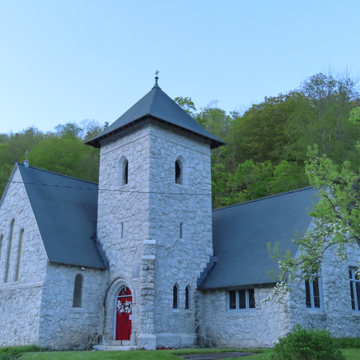You are here
Mission of the Church of Our Saviour (Mission Farm)
This stone church set amidst apple trees and hayfields in the narrow upper Ottauquechee Valley reflects Vermont Episcopalians' preference for English Gothic as well as Rutland robber barons' interest in the mountains to the east as recreation began to displace lumbering. In the 1890s lodges were built at Pico and Killington peaks, followed over the next decades by the private mountain retreats of the Proctor, Clement, and Mead families in the towns of Mendon and Sherburne (renamed Killington in 1999). Though not publicly accessible, the most remarkable of these was the spectacularly sited circular stone lodge that Brad Mead, founder of the Pico resort, built in Mendon around 1930. The building's stony character and steep wood-shingled roof was prefigured by a Gothic Revival mission church standing on the old Rutland to Bridgewater turnpike and serving the towns of Sherburne, Bridgewater, and Plymouth. Elizabeth Wood Clement, widow of Rutland marble, banking, and railroad magnate Charles Clement, built the church on her grandfather's farm and donated it to Vermont's Episcopal diocese. London-born, Edinburgh-trained Arthur H. Smith, who had opened a practice in Rutland only two years earlier, produced a T-shaped design consisting of a nave and parish hall about a square reentrant entrance tower with a solidity and directness of rural England and Arts and Crafts. Uncoursed walls of rock-faced white Plymouth granite are marked by clustered lancet windows atop a molded belt course. They carry steep unbroken roofs (the original wood shingles now replaced with asphalt) with exposed, jigsawn rafter tails. The massiveness of the three-story tower is emphasized by a splayed portal and a diagonal stepped buttress on its exposed corner. Originally flat roofed, the tower's picturesque quality was enhanced by a pyramidal cap with flared eaves added in 1905 to counter leakage. There is a warm wood interior with a pointed, bead-board ceiling on chamfered rafters and carved oak furnishings, altar rail, and reredos. The interior is further enriched with a rood corpus carved in Oberammergau by Anton Haser.
Writing Credits
If SAH Archipedia has been useful to you, please consider supporting it.
SAH Archipedia tells the story of the United States through its buildings, landscapes, and cities. This freely available resource empowers the public with authoritative knowledge that deepens their understanding and appreciation of the built environment. But the Society of Architectural Historians, which created SAH Archipedia with University of Virginia Press, needs your support to maintain the high-caliber research, writing, photography, cartography, editing, design, and programming that make SAH Archipedia a trusted online resource available to all who value the history of place, heritage tourism, and learning.


